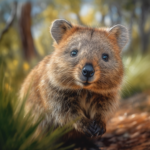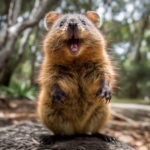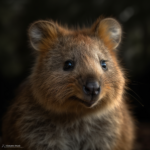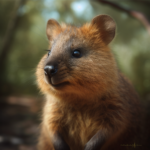The Introduction
Quokkas and quolls are two unique and fascinating Australian animals that often get confused due to their similar-sounding names. While both of them are small marsupials, they belong to different families and have distinct characteristics. Quokkas are known for their adorable and friendly nature, often referred to as the “happiest animal on Earth,” while quolls are carnivorous predators with a reputation for being skilled hunters. In this article, we will delve into the world of quokkas and quolls, exploring their features, habitats, behaviors, and the key differences that set them apart. So, let’s embark on this journey to discover the wonders of these captivating creatures!
Key Takeaways
- Quokkas and quolls are both small marsupials found in Australia.
- Quokkas are known for their friendly and curious nature, while quolls are more elusive and carnivorous.
- Quokkas have a round face and a compact body, while quolls have a pointed snout and a slender body.
- Quokkas are herbivorous and primarily feed on vegetation, while quolls are carnivorous and hunt small animals.
- Both quokkas and quolls are protected species due to their declining populations and habitat loss.
Understanding Quokkas

A. What is a Quokka?
When it comes to unique and adorable animals, the quokka definitely takes the spotlight. Native to Western Australia, the quokka is a small marsupial that belongs to the macropod family, which includes kangaroos and wallabies. Quokkas are known for their friendly and curious nature, making them a popular attraction for tourists and nature enthusiasts alike.
Quokkas are about the size of a domestic cat, with a round body and a short tail. They have a stocky build, which allows them to move quickly and efficiently through their natural habitat. One of the most distinctive features of the quokka is its friendly face, with a perpetually smiling expression that has earned it the title of “the happiest animal on Earth.”
B. Where do Quokkas Live?
Quokkas are found primarily on Rottnest Island, just off the coast of Perth, Western Australia. This island is a protected reserve, providing a safe haven for the quokka population. In addition to Rottnest Island, quokkas can also be found on some parts of the mainland, including small pockets of forest and scrubland.
C. Quokka: The Australian Icon
The quokka has become an iconic symbol of Australia, representing the country’s unique and diverse wildlife. Its friendly and photogenic nature has made it a social media sensation, with countless selfies and photos featuring these adorable creatures flooding the internet.
D. Quokka vs Squirrel: Spotting the Differences
While quokkas may bear some resemblance to squirrels, there are several key differences between the two. Quokkas are marsupials, meaning they carry their young in a pouch, whereas squirrels are rodents. Quokkas also have a more rounded body shape compared to the slender build of squirrels. Additionally, quokkas have a unique smile that squirrels don’t possess.
E. Quokka vs Wombat: A Comparative Study
Quokkas and wombats are both native to Australia and share some similarities, but they are distinct species. Quokkas are smaller and more agile, while wombats are larger and have a stockier build. Wombats are known for their burrowing behavior, while quokkas are more active and can be seen hopping around their habitat.
F. Quokka vs Kangaroo: Understanding the Differences
Quokkas and kangaroos are both marsupials, but they have significant differences in size and behavior. Quokkas are much smaller than kangaroos, with an average height of about 50 centimeters. Kangaroos, on the other hand, can grow to be over two meters tall. Quokkas are also more social and less timid compared to kangaroos, which are known for their powerful kicks.
G. Quokka vs Capybara: A Unique Comparison
While quokkas and capybaras share some similarities, they are native to different parts of the world. Quokkas are found in Australia, while capybaras are native to South America. Capybaras are the largest rodents in the world, while quokkas belong to the macropod family. Both animals have a friendly and sociable nature, making them popular attractions for visitors.
H. Quokka vs Koala: A Detailed Contrast
Quokkas and koalas are both iconic Australian animals, but they have distinct characteristics. Quokkas are small and agile, while koalas are larger and more slow-moving. Koalas are arboreal and spend most of their time in trees, while quokkas are ground-dwelling creatures. Additionally, koalas feed exclusively on eucalyptus leaves, while quokkas have a more varied diet consisting of grasses, leaves, and stems.
In conclusion, quokkas are fascinating creatures that have captured the hearts of people around the world. Their unique appearance, friendly nature, and status as an Australian icon make them a beloved species. Understanding the differences between quokkas and other animals, such as squirrels, wombats, kangaroos, capybaras, and koalas, allows us to appreciate the diversity of wildlife and the importance of conservation efforts to protect these remarkable creatures.
Delving into the Life of Quokkas
A. Are Quokkas Vicious or Friendly?
When it comes to the quokka, its friendly and approachable nature is what sets it apart from other animals. Quokkas are known for their sociable behavior and their willingness to interact with humans. These small marsupials, native to Western Australia, have gained quite a reputation for their friendly demeanor. In fact, they have been dubbed the “happiest animal on Earth” due to their seemingly constant smile.
Quokkas are not vicious creatures by any means. They are generally docile and non-aggressive, making them safe to approach and observe. While they may appear cute and cuddly, it’s important to remember that they are still wild animals and should be treated with respect. It’s always best to admire them from a safe distance and avoid touching or feeding them, as this can disrupt their natural behavior and potentially harm them.
B. Are Quokkas Smart?
Quokkas may not be known for their intelligence like some other animals, but they are certainly resourceful in their own way. These marsupials have adapted to survive in the harsh Australian environment, where food and water can be scarce. They have developed a keen sense of smell and are able to locate food sources, even in dense vegetation.
While quokkas may not possess the problem-solving abilities of some other animals, they have evolved to be highly efficient in their natural habitat. They are skilled climbers and can navigate through trees and shrubs with ease. Quokkas also have a strong sense of self-preservation and are able to quickly escape from potential threats.
C. How Quokkas Escape Predators
Quokkas have a few tricks up their sleeves when it comes to evading predators. One of their main defense mechanisms is their agility and speed. Quokkas are excellent jumpers and can quickly leap away from danger. They are also adept swimmers and can take refuge in water if necessary.
Another interesting adaptation of quokkas is their ability to climb trees. This allows them to escape predators that may be unable to follow them into the treetops. By utilizing their strong hind legs and sharp claws, quokkas can reach higher ground and find safety among the branches.
D. Quokka Eating Habits
Quokkas are herbivores, meaning they primarily feed on plant matter. Their diet consists mainly of grasses, leaves, bark, and fruits. They have a unique ability to extract moisture from their food, which allows them to survive in arid environments where water is scarce.
Quokkas are known to have a selective palate and will often choose the most nutritious parts of plants to eat. They have been observed using their front paws to hold food while they nibble on it. This dexterity allows them to efficiently consume their preferred food sources.
E. Can a Quokka Quack? Debunking Myths
There is a common misconception that quokkas can quack like ducks. However, this is simply a myth. Quokkas do not have the vocal apparatus necessary to produce quacking sounds. Instead, they communicate through a variety of other vocalizations, such as hisses, barks, and grunts.
Quokkas also use body language to communicate with each other. They can display aggression by baring their teeth or puffing up their fur. On the other hand, a relaxed quokka may exhibit a relaxed posture and a gentle sway of its tail.
In conclusion, quokkas are friendly, adaptable, and resourceful creatures. Their unique characteristics and behaviors make them a fascinating species to study and observe. While they may not possess the intelligence of some other animals, they have developed remarkable survival strategies that allow them to thrive in their natural habitat. So, if you ever have the opportunity to encounter a quokka, remember to appreciate their beauty from a respectful distance and enjoy their infectious smile.
Meeting a Quokka
A. How to Meet a Quokka
If you’re planning a trip to Australia, one of the most exciting experiences you can have is meeting a quokka. These adorable marsupials are native to Western Australia and are known for their friendly and curious nature. Here are a few tips on how to make the most of your encounter with these delightful creatures.
-
Visit Rottnest Island: The best place to see quokkas in their natural habitat is on Rottnest Island, located just off the coast of Perth. The island is home to a large population of quokkas, and they can be easily spotted roaming freely around the island.
-
Respect their space: While quokkas are generally friendly, it’s important to remember that they are wild animals. It’s best to observe them from a distance and avoid touching or feeding them. This will ensure their safety and well-being.
-
Be patient: Quokkas are most active during the early morning and late afternoon, so plan your visit accordingly. Take your time to explore the island and keep an eye out for these adorable creatures. They are known to be curious and may approach you if they feel comfortable.
-
Capture the moment: Quokkas are famous for their photogenic nature, and taking a selfie with one has become a popular trend. However, it’s important to remember that the welfare of the animal should always come first. Avoid using flash photography and be mindful of their personal space.
B. How to Use Quokka: A Guide for Tourists
Apart from meeting quokkas in person, there’s another way to experience their charm – through the Quokka app. Developed specifically for tourists visiting Rottnest Island, the Quokka app is a handy tool that provides information and guidance during your visit. Here’s how you can make the most of this app:
-
Download the app: Before your trip, make sure to download the Quokka app on your smartphone. It’s available for both iOS and Android devices and can be easily found in the app store.
-
Explore the island: The app offers a detailed map of Rottnest Island, highlighting the best spots to see quokkas. It also provides information about the island’s history, attractions, and facilities, making it a valuable resource for tourists.
-
Learn about quokkas: The Quokka app features a section dedicated to quokka facts, allowing you to learn more about these fascinating creatures. Discover their behavior, diet, and conservation status, and gain a deeper understanding of their importance in the ecosystem.
-
Share your experience: The app allows you to share your quokka encounters with friends and family through social media. Capture your favorite moments and spread the joy of meeting these adorable marsupials.
By following these tips and utilizing the Quokka app, you can have a memorable and responsible experience with quokkas. Remember to always respect their natural habitat and enjoy the privilege of witnessing these unique creatures in the wild.
Understanding Quolls

A. What is a Quoll?
Quolls are fascinating creatures that belong to the marsupial family. They are native to Australia and are often referred to as “native cats” due to their cat-like appearance. Quolls are small to medium-sized animals, with the largest species being about the size of a domestic cat. They have a distinctive appearance, with short legs, a long tail, and a pointed snout.
One of the most interesting features of quolls is their pouch. Like other marsupials, female quolls have a pouch on their belly where they carry and nurse their young, known as joeys. The joeys are born underdeveloped and spend several months in the pouch, growing and developing before they are ready to venture out into the world.
B. Quoll: A Lesser-Known Australian Native
While quokkas often steal the spotlight when it comes to Australian wildlife, quolls are equally deserving of attention. These nocturnal creatures are known for their agility and hunting skills. Quolls have sharp teeth and claws, which they use to catch and kill their prey. They are skilled climbers and can often be found in trees, hunting for small mammals, birds, reptiles, and insects.
Quolls are solitary animals, preferring to live alone rather than in groups. They are territorial and mark their territory with scent markings. Despite their solitary nature, quolls are not completely anti-social. They communicate with each other through vocalizations, including growls, hisses, and barks.
Quolls are also known for their adaptability. They can thrive in a variety of habitats, including forests, woodlands, and even urban areas. However, their population has been declining due to habitat loss and predation by introduced species such as foxes and cats.
In terms of conservation status, some species of quolls are listed as endangered or vulnerable. Efforts are being made to protect their habitats and control the population of introduced predators to ensure the survival of these unique Australian natives.
In summary, quolls are fascinating marsupials that are often overshadowed by their more famous counterparts. Their unique characteristics, hunting abilities, and adaptability make them an important part of Australia’s wildlife. It’s important to appreciate and protect these lesser-known creatures to ensure their survival for future generations.
Quokka vs Quoll: The Showdown

A. Physical Differences between Quokka and Quoll
When it comes to comparing the physical characteristics of the quokka and the quoll, there are several noticeable differences between the two species.
Quokka Characteristics:
- Size: Quokkas are small marsupials, measuring around 40 to 54 centimeters in length and weighing between 2.5 to 5 kilograms.
- Appearance: These adorable creatures have round faces, small ears, and a compact body. They have short, coarse fur that is usually brown or gray in color, with a lighter underbelly.
- Tail: Quokkas have a short, thick tail that is about 25 to 30 centimeters long.
Quoll Features:
- Size: Quolls, on the other hand, are slightly larger than quokkas. They can grow up to 75 centimeters in length, including their tail, and weigh between 1 to 7 kilograms.
- Appearance: Quolls have a slender body with a pointed snout and large, rounded ears. Their fur can vary in color, ranging from brown, black, or gray, with spots or stripes.
- Tail: Quolls have a long, bushy tail that can measure up to 35 centimeters in length.
B. Behavioral Differences: Quokka and Quoll
Apart from their physical differences, quokkas and quolls also exhibit distinct behaviors that set them apart.
Quokka Behavior:
- Social Nature: Quokkas are known for their friendly and sociable behavior. They are often referred to as the “happiest animal on Earth” due to their seemingly perpetual smile. They are not afraid of humans and are often found approaching tourists on Rottnest Island in Western Australia.
- Herbivorous Diet: Quokkas are primarily herbivores, feeding on grasses, leaves, and bark. They have a unique ability to survive on minimal water, obtaining most of their hydration from the vegetation they consume.
- Reproduction: Quokkas have a short gestation period of around 27 to 28 days. They give birth to a single joey, which stays in the mother’s pouch for about six months before venturing out.
Quoll Behavior:
- Solitary Nature: Quolls, on the other hand, are solitary animals. They are nocturnal and spend most of their time hunting for food during the night. They are skilled climbers and often take refuge in trees.
- Carnivorous Diet: Quolls are carnivores, feeding on a variety of prey including small mammals, birds, reptiles, and insects. They are skilled hunters and have sharp teeth and claws to aid in capturing their prey.
- Reproduction: Quolls have a longer gestation period compared to quokkas, lasting around 21 to 24 days. They give birth to multiple joeys, which stay in the mother’s pouch for about 10 to 11 weeks.
C. Habitat and Lifestyle: Quokka vs Quoll
Quokka Habitat:
- Quokkas are native to Western Australia and are primarily found on Rottnest Island, as well as in some parts of the mainland. They inhabit a range of habitats, including forests, scrublands, and coastal areas.
- Lifestyle: Quokkas are diurnal animals, meaning they are active during the day. They spend their time foraging for food, grooming, and socializing with other quokkas.
Quoll Habitat:
- Quolls are found in various habitats across Australia, including forests, woodlands, and grasslands. They have a wider distribution compared to quokkas and can be found in both mainland Australia and Tasmania.
- Lifestyle: Quolls are primarily nocturnal, which means they are most active during the night. They spend their nights hunting for prey and marking their territory with scent markings.
In conclusion, while both the quokka and the quoll are native Australian marsupials, they have distinct physical characteristics, behaviors, and habitats. The quokka is known for its friendly and sociable nature, herbivorous diet, and preference for coastal areas, while the quoll is solitary, carnivorous, and adapts to various habitats across Australia. Understanding these differences helps us appreciate the unique qualities of these fascinating creatures. Conclusion
In conclusion, both the quokka and the quoll are fascinating Australian marsupials that have captured the hearts of many. While they may share a few similarities, such as their native habitat and their adorable appearance, they are quite different in terms of their size, diet, behavior, and conservation status. The quokka, with its friendly and photogenic nature, has become an internet sensation and a symbol of happiness. On the other hand, the quoll, with its carnivorous diet and nocturnal habits, is a skilled predator in the Australian ecosystem. Both species play important roles in maintaining the balance of their respective ecosystems. However, they face different conservation challenges, with the quokka being classified as vulnerable and the quoll facing various threats that have led to some species being endangered. It is crucial that we continue to protect and preserve these unique and wonderful creatures for future generations to appreciate and enjoy. So, whether you find yourself captivated by the quokka’s smile or intrigued by the quoll’s hunting prowess, both animals deserve our admiration and conservation efforts.
Frequently Asked Questions
Q1: Are quokkas vicious?
No, quokkas are not typically vicious. They are known for their friendly and curious nature. However, like any wild animal, they can become defensive if they feel threatened.
Q2: Where do quokkas live?
Quokkas are native to Australia and are primarily found on smaller offshore islands such as Rottnest Island and Bald Island. They also inhabit some mainland areas in Western Australia.
Q3: How do quokkas escape predators?
Quokkas are agile climbers, which helps them to escape from predators. They also have a unique defense mechanism where they can eject their offspring from their pouches to distract predators and make a quick escape.
Q4: What’s the difference between a quokka and a squirrel?
While both are small mammals, quokkas are marsupials, meaning they carry their young in a pouch, while squirrels are rodents. Quokkas are also larger than most squirrels and have a different diet and habitat.
Q5: How can I meet a quokka?
The best place to meet a quokka is on Rottnest Island in Western Australia. The island is a protected nature reserve where quokkas roam freely.
Q6: What’s the difference between a quokka and a wombat?
Both are marsupials, but they differ in size, habitat, and behavior. Wombats are larger, burrow underground, and are mostly nocturnal, while quokkas are smaller, live above ground, and are nocturnal and diurnal.
Q7: Can a quokka quack?
No, quokkas do not quack. They communicate through a series of grunts, clicks, and hisses.
Q8: What’s the difference between a quokka and a quoll?
Quokkas and quolls are both Australian marsupials, but they belong to different families. Quokkas are wallabies, while quolls are carnivorous marsupials. They also differ in size, diet, and habitat.
Q9: Are quokkas smart?
Quokkas have shown signs of problem-solving abilities, but there is currently no comprehensive research on their intelligence. They are known to be curious and friendly towards humans.
Q10: How do you pronounce ‘quokka’?
The word ‘quokka’ is pronounced as ‘Kwok-uh’.




